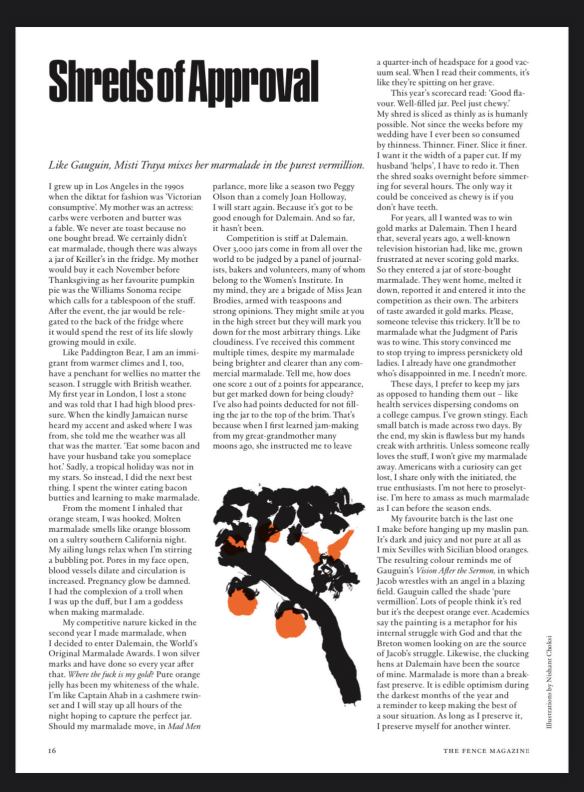Yesterday marked seventy-seven years since It’s a Wonderful Life premiered at the Globe Theatre in New York. Yesterday was also my first day making marmalade since hanging up my maslin pan in January. Naturally, I named this winter’s inaugural batch after the film. I suppose it was also a nod to Donna Reed who acted in the role of Mary Hatch Bailey. She was born in Denison, Iowa, not more than 30 minutes from where the corn is always knee-high by the fourth of July and my family resides in Harlan. I hope this batch serves as a reminder: No matter how bitter things may seem, remember there is still sweetness.
If you’re familiar with this blog, or you know me at all, then you’re aware I’ve been making marmalade for a long time. It started with my Indefinite Leave to Remain application in 2015 and culminated with me receiving silver marks at Dalemain six years in a row. I was the Raymond Poulidor of pure orange jelly, the Susan Lucci of Seville marmalade, a perpetual bridesmaid but never a bride. Last winter, I wrote about my marmalade obsession and my silver medalist syndrome for a magazine. Today, I’d like to share it with you. I’d also like to share my marmalade recipe as it’s changed over the years. My wish is that when you taste it, it makes you feel like George Bailey lassoing the moon.

Seville orange marmalade recipe
Ingredients:
1 kg of Seville oranges
Preserving sugar (the larger crystals dissolve slower than granulated or caster which means less froth, less skimming, and a clearer preserve)
A lemon
Equipment:
Maslin pan or the largest heavy bottom pan you can find
Cheesecloth (I buy bags made of it)
Chopping board
Large bowl
Knife
Teaspoon
Citrus reamer
Spatula
Small plate
Clean jars with lids
Ladle
Funnel (optional)
Method:
Day one:
Place your cheesecloth in a large bowl. Keep your maslin pan on the side.
Wash the oranges and pat them dry. Cut them in half and juice them. Pour the juice into the bowl with the cheesecloth. Now scrape the insides of the orange halves with your spoon. The goal is to remove as much pith as possible as it’s pith is that can make marmalade taste really bitter. Place the pith and seeds in the cheesecloth bowl.
Slice your shred. Personally, I like mine thinner, matchstick style, but sometimes, depending on how dull my knives are, this just isn’t possible. Place the shred in the maslin pan. I usually only shred 2/3 of my oranges and put the rest in the cheesecloth bag with everything else. Feel free to use it all if you like. I just prefer a high jelly content.
Add 2 1/4 litres of water to your maslin pan which should now contain the shred and the bag of strained juice/seeds/pith/peel you didn’t slice. Cover it all with plastic wrap and leave it to soak overnight. This step is crucial as it infuses the water with pectin and flavour as well as softens the shred.
Day two:
Bring the contents of the maslin pan to a boil then simmer until the shred is tender and the contents of the pan have been reduced by 1/3.
Stick your small plate in the freezer and heat your clean jars in a warm oven.
Let the mixture cool. When it has, squeeze the cheesecloth to extract as much pectin as you can. Pectin is what sets your marmalade and gives it a wonderful wobble. Once you have done this, discard the cheesecloth and its remaining contents.
Add the juice of a lemon (once again, this is for pectin) and 800 g of sugar for each litre of liquid and shred that remains. Stir this over a low flame until the sugar completely dissolves.
Once the sugar’s dissolved, turn up the heat and let it boil. Remove any scum that foams on the surface. This can generally be avoided, as previously stated, by using preserving sugar. Over time, the consistency and colour will change. In my experience, it usually takes about 45 minutes of boiling to achieve the set I like. Do test for set early and often. The way to do this is by going round the edges of your pan with a spatula then holding it sideways. Does the mixture run off like liquid or does it cling then drop like jelly? This is known as the flake test. The other method for testing is with a frozen plate. Drop a small teaspoon of the molten mixture on the plate then stick it back in the freezer for a minute. When you remove it, push the drop with your finger. If it wrinkles, it’s set.
Once your marmalade is set, take it off the heat and allow it to cool for at least ten minutes before potting. If you pot it while it’s still very hot, all the shred will float to the top. I use a funnel when potting my marmalade, but you don’t need one. I don’t dare assume everyone’s ladling skills are as shaky as mine.




